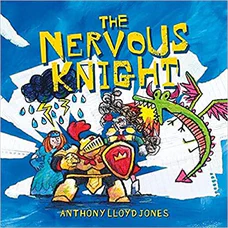The Nervous Knight
A Story about Overcoming Worries and Anxiety
Written and illustrated by Lloyd Jones
48 pages
•
Published 2021 (Jessica Kingsley Publishers)

Recommended Age Range: Kindergarten through 2nd grade, maybe 3rd.
Publisher's Summary:
Once upon a time, in a peaceful kingdom far away, there lived a knight (in training). This knight was never ever seen without their armour. In fact, nobody even knew what they looked like under their helmet. Why would they remove their armour? You never know what might happen. What if there was suddenly a war, or an exploding volcano, or they fell and scraped their knee?! The Nervous Knight shows what childhood anxiety can look like, while helping to normalise it and show children (ages 5+) that they can do the things they care about despite their worries. It also contains a guide for parents and professionals, giving expert advice on how to use the book to aid discussions on this topic.

Dr. Annie's Takeaways
Recommended for: A child with a lot of safety-oriented worries who is at all interested in knights or medieval lore. This story destigmatizes anxiety (knights are inherently cool and brave, right?) and presents the value of exposure (i.e., doing things they care about even if they’re scary) and expectancy violations (i.e., bad outcomes happen, and they’re not nearly as bad as the knight expected). Different coping strategies are briefly shared by the knight’s classmates (also knights), which might give these techniques a bit of extra credibility! The knight is particularly anxious about participating in jousting practice in front of his classmates; this will likely resonate with children who experience significant anxiety in performance situations (e.g., sporting events, recitals, etc.).
Would a child like it? Many children would enjoy this book. It has a bit of silliness that is never making fun, and it’s heartfelt without being saccharine.
Tone: Serious, yet hopeful; the illustrations brighten up the story and make it more cheerful.
Story Quality: This story works on two levels and is ultimately an ode to the strength required to be vulnerable. On the surface, it is a story about a knight who is scared of many things and wears armor at all times to protect themself. The knight’s armor also functions as a metaphor about how excessive self-protection (physical or emotional) can weigh a person down and get in the way of important activities and relationships. It’s earnest and although set in a fantasy world that blends medieval and modern, it has an authentic feel to it. I like books that bring up big ideas to kids, and this book encourages kids to grapple with what is gained and what is sacrificed when one focuses on staying as safe as possible. Fans of Jones’s Princess and the Fog will appreciate the Princess’s cameo.
Illustrations: Colorful, bold, almost messy drawings with a lot of motion and details to look at. They have a slight edge to them that has a flavor of comic book illustrations.
Representation: The knight uses they/them pronouns, and they have brown skin and brown curly hair. The knight’s classmates appear to be boys and girls of different races and abilities, including a child in a wheelchair (plus an alien!). A White girl teaches the knight how to joust so that they can join their classmates. The story has a fun mix of medieval (e.g., knights) and modern (e.g., going out for ice cream) elements.
Psychological Practices: The story begins with a great description of anxiety symptoms–the knight has many worries and stomach aches, and they often cry, feel shaky, and avoid anxiety-inducing activities (e.g., fun social activities and jousting practice). They wear their armor at all times to protect themself (even in the bath). The story then presents an exposure challenge
–the knight is encouraged by a classmate to give jousting a try, and when they finally do, they fall off their horse. “The worst thing they could have imagined just happened!” But none of their fears end up coming true, and in fact, their classmates validate the knight’s worries and share with the knight what they do when they’re feeling worried– (e.g., thinking of the good things that could happen, grounding techniques, going for a walk, talking to a friend). As the knight practices these strategies, they’re increasingly able to take off their armor, and they realize how much easier it is to participate in fun activities without it (“And none of it was as scary as they thought it would be!”).
Concerns: None
